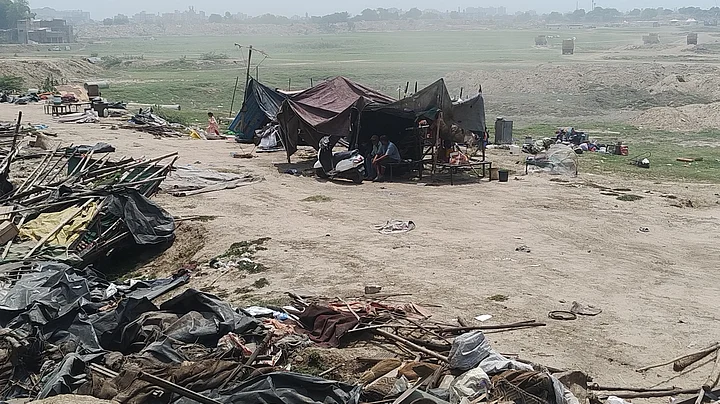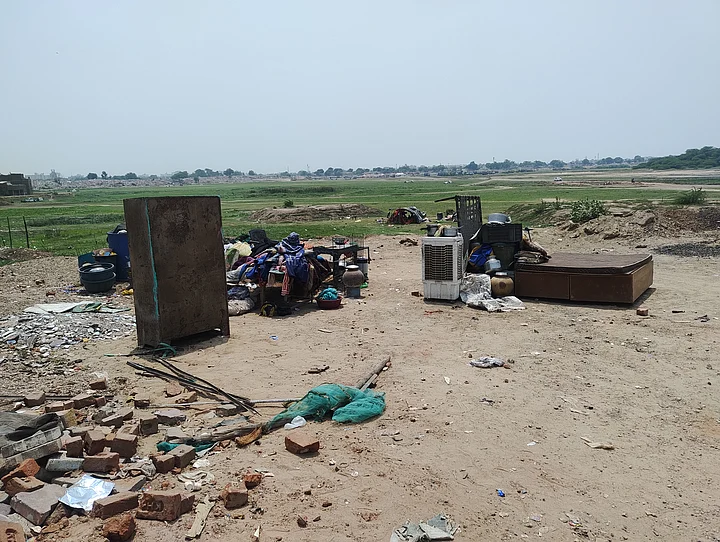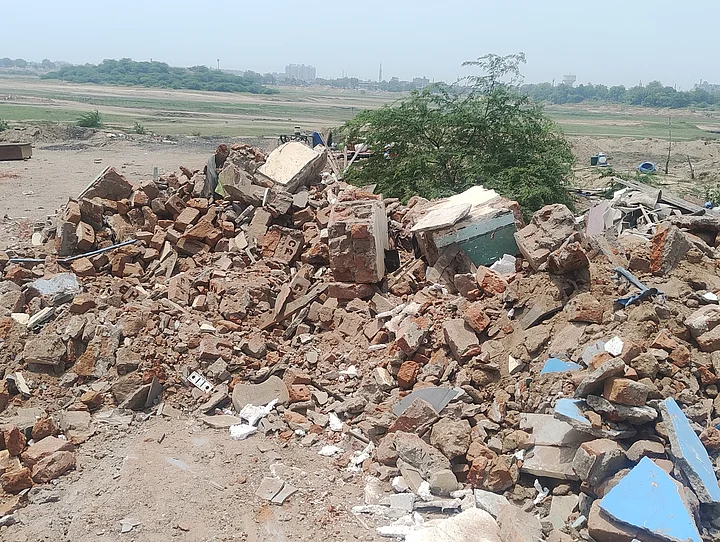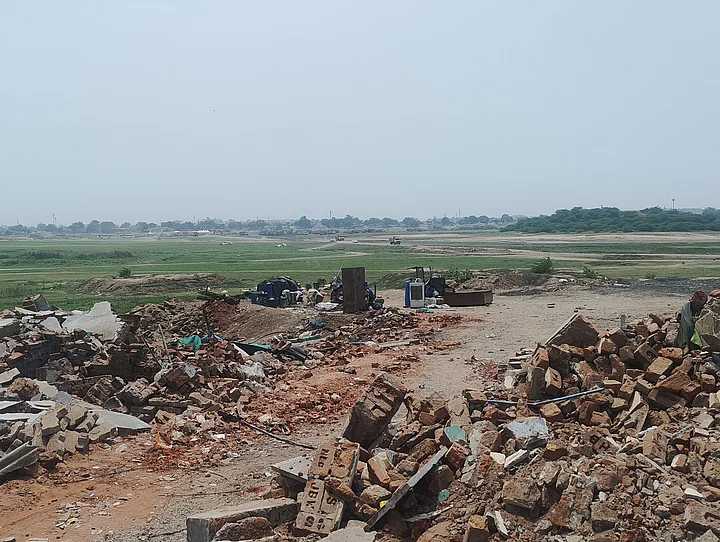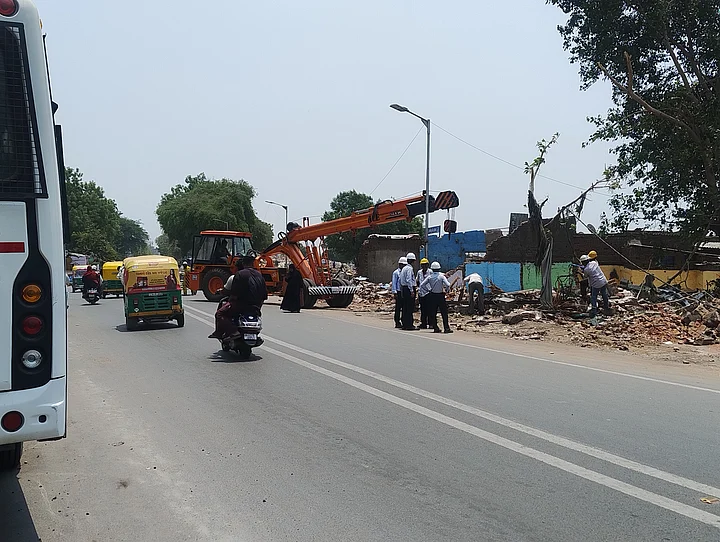“I’ve called Chandola my home since 2005,” said a 50-year-old man, his voice heavy with anger. “For the last 15–20 days, they cut off our electricity and water. Then came just a verbal warning telling us to leave by 20 May. Before we could even understand what was happening, the bulldozers came. I watched helplessly as my home was torn down.”
In a sweeping operation, being described as one of Gujarat’s largest anti-encroachment drives, the Ahmedabad Municipal Corporation (AMC) demolished over 10,000 illegal structures around Chandola Lake in Danilimda, reclaiming approximately 4 lakh square meters of public land.
Conducted in two phases on 29 April and 20 May, the operation aimed to restore the ecological integrity of the lake while addressing national security concerns linked to illegal settlements.
The drive, however, has ignited a fierce debate over human rights violations, lack of due process, and the future of displaced residents, many of whom claim Indian citizenship and long-term residency.
Operation Overview: Scale and Execution
Chandola Lake, a British-era water body spanning 109.6 hectares, is one of Ahmedabad’s largest lakes. Once a critical component of the city’s water management system, it had been heavily encroached upon over decades, with 4 lakh square meters of its 11 lakh square meter area occupied by illegal structures, including huts, shops, resorts, and parking lots. Garbage dumping had further degraded the lake, reducing its capacity and transforming parts of it into dry land.
Govt Describes Phase 1 as Strong Move Against 'Anti-National Elements'
In the first phase, the AMC removed over 2,000 illegal structures near Chandola Lake, reclaiming nearly one lakh square meters of government land. The operation began on 29 April and was carried out with tight security—more than 2,000 police personnel, 15 SRP units, 74 JCB machines, 200 trucks, and 20 electricity teams were involved.
The state government described the action as a strong move against “anti-national elements,” alleging the area was home to illegal Bangladeshi immigrants, Al-Qaeda sleeper cells, drug rackets, prostitution, and fake document networks.
A midnight raid on 26 April panicked residents of Chandola Talav na Chhapra, leading to the detention of 890 people—including 214 minors—in a crackdown purportedly aimed at identifying alleged Bangladeshi immigrants following the recent Pahalgam attack.
While 300 detainees were released after verifying their Indian citizenship, a sense of anxiety continues to grip this southern Ahmedabad slum.
Authorities have confirmed 143 individuals as illegal immigrants, with 110 accused of possessing forged identity documents. Ahmedabad Police Commissioner Gyanender Singh Malik defended the operation, stating “Everyone in that area is a land-grabber,” a remark that has deepened the unease among local residents.
One main target of the operation was Lalla Pathan, also known as Lallu Bihari, who was arrested with his son. Once seen by migrants as a helper, he is now accused of building a criminal network over 20 years, involving land grabbing, human trafficking, extortion, and illegal businesses. His farmhouse was among the first to be demolished.
Police say he took advantage of migrant families by giving them shelter while keeping them dependent and scared. His arrest is part of Gujarat Police’s broader 100-day campaign against “anti-social elements,” launched after a violent incident during Holi in Vastral on 13 March.
Gujarat’s DGP Vikas Sahay said 7,157 people have been identified in the crackdown so far, with 372 illegal structures demolished and 1,046 electricity connections cut across the state.
8,500 Structures Demolished in Phase 2 With 50 Bulldozers
The second phase saw 8,500 structures demolished on 20-21 May, freeing 2.5 lakh square meters in two days. On 21 May, the AMC removed the remaining structures, including religious structures, under heavy security with over 3,000 police personnel and 50 bulldozers.
The AMC has since initiated debris clearance, lake bed deepening, and the construction of a precast boundary wall to prevent re-encroachment. Plans are underway to fill the lake with 5,000–6,000 million litres of treated water from the Pirana Sewage Treatment Plant, aiming to restore its original circular form and develop it as a public lakefront.
Gujarat HC Rejects Residents' Petitions But Allows Them to Seek Rehabilitation
On 28 April, residents of Siyasatnagar near Chandola Lake, represented by advocate Anand Yagnik, filed an urgent petition in the Gujarat High Court. They argued that the AMC demolished their homes without prior notice, violating their rights under Articles 14 and 21 of the Constitution. They also sought rehabilitation under the state’s 2010 and 2013 resettlement policies, citing long-term residence, and referred to Supreme Court guidelines requiring due process in eviction cases.
Yagnik called the demolitions illegal and unconstitutional, saying the government failed to issue notices or provide alternative housing. He also opposed the branding of residents as illegal immigrants, noting many had lived there since before 2010.
In response, Advocate General Kamal Trivedi defended the demolition as a necessary step for national security and public safety. He said the area was linked to illegal activities and many residents were undocumented immigrants. He emphasized that the action was not a routine anti-encroachment drive but a targeted operation based on sensitive intelligence.
On 29 April, Justice Mauna Bhatt dismissed the petition. Citing a 2024 Supreme Court ruling, the high court held that illegal structures on public land, especially water bodies, are not entitled to legal protection.
The court asserted that staying the demolition would amount to perpetuating illegal occupation/construction, which would be against the law. However, the court allowed the residents to submit individual applications for rehabilitation, to be considered under existing laws.
On 5 May, 58 residents of C- Wards Chapara near Chandola Lake filed a fresh petition in the Gujarat High Court. Their counsel Senior Advocate Mihir Joshi submitted in court that all 58 residents belong to Economically Weaker Sections (EWS) and had come to city looking for livelihood. They demanded a stay on the demolition drive.
Having not been able to afford a rented roof or shelter, the petitioners constructed huts along Chandola Lake's periphery and have been residing there for more than 60 years.
But Justice Mauna Bhatt rejected their petition too. The high court noted that although the petitioners belong to the EWS category, their illegal and unauthorized constructions on lake or government land cannot be overlooked.
Regarding their right to shelter and livelihood, the court stated that the petitioners can apply individually to the concerned authority with proper documents.
The Court also referred to a recent Supreme Court ruling which says that illegal constructions cannot be regularised, as it goes against the rule of law. However, the Court clarified that the petitioners can still apply for alternative housing under the state government’s rehabilitation scheme. If they are eligible and submit the required documents, the authorities must consider their applications as per the law.
'My Kids Were More Scared than During Covid Lockdown': Resident
The demolition drive at Chandola Lake left many residents and activists outraged. The midnight raid, where families were rounded up, paraded through streets, and held at Kankaria football ground before being taken to Gaekwad Haveli, caused widespread fear and trauma.
A resident from Madhya Pradesh told The Indian Express, “My kids were more scared than during the Covid lockdown.”
Binaben Jadav from Rahethan Adhikar Manch (RAM) described the chaos during the first phase: “People were terrified. Many were detained, and women didn’t know where their husbands were. Some didn’t eat or bathe for days. Poverty, not illegal status, is the real reason for their suffering—most Chandola residents are poor.”
Rents Soar in Nearby Areas As Hundreds Homeless in Scorching Heat
RAM, a housing rights group, wrote to the AMC that some Chandola Lake residents have lived there for over 80 years. Many lost their homes in the 2002 riots and were given government camp cards.
In 2009, after previous demolitions, the Gujarat High Court ordered housing for 172 families, but only 44 have been resettled. With Ahmedabad’s temperatures reaching 43°C, RAM demanded urgent help, including clean water and temporary shelters for those evicted.
The evictions sparked a housing crisis in nearby Danilimda and Isanpur, where rents soared from Rs 2,000–3,000 to Rs 5,000–10,000. Many families are struggling to find homes, facing discrimination after being wrongly called “Bangladeshi.”
While handing out 3,600 forms for housing under the Pradhan Mantri Awas Yojana, AMC officials said residents with proof of living there before December 2010 will get homes without a lottery, which is only for assigning units.
The AMC has told beneficiaries that they need to pay Rs 3 lakh in total to buy a house, with monthly payments of Rs 30,000 for 10 months. This has caused political reactions.
While Congress MLA Shailesh Parmar wrote to Gujarat Chief Minister Bhupendra Patel; Leader of Opposition Shehzad Khan Pathan wrote to AMC Commissioner Banchanidhi Pani, asking for the monthly installments to be lowered to Rs 5,000 so that very poor families who earn daily wages can afford it.
Currently, only 33 people are staying in a Vasna shelter with food, water, and bedding
Many Detainees from UP & Bihar Not Bangladesh
Following the high court's rejection of the petitions, Gujarat MoS (Home) Harsh Sanghavi took to X, accusing “Congress sympathizers” of trying to protect illegal immigrants. Sanghavi claimed that the court ruling was a victory as it had foiled attempts to shield Bangladeshi and Pakistani migrants.
Dr Manish Doshi, spokesperson for the Gujarat Pradesh Congress Committee (GPCC), criticized the ruling party. He asked, why did the BJP government fail to address illegal settlements earlier despite being in power in Gujarat for over three decades.
Doshi argued that the BJP’s narrative was misleading and stated that during the UPA I and II governments under former PM Dr Manmohan Singh, 82,000 Bangladeshis were deported, compared to 18,000 deportations under the Modi government in 11 years.
Activists have been working to secure the release of detained Indian nationals. Advocate Shamshad Pathan, who spoke with The Indian Express, mentioned that many individuals detained during the operation were from various parts of India, including Bihar, Rajasthan, and Uttar Pradesh and that they had been mistakenly identified as illegal immigrants.
Local officials in Bihar confirmed the identity of some detainees, leading to their release. Raising concerns on social media, Ritu Jaiswal, State President of the Women’s Wing of the Rashtriya Janata Dal (RJD) in Bihar, highlighted that several youths from Bihar were caught up in the operation.
She emphasized that they were Indian citizens, not illegal immigrants.
The Chandola Lake operation underscores a complex interplay of national security, ecological restoration, and human rights. While the AMC aims to rejuvenate the lake and curb illegal activities, the lack of prior notice, limited immediate rehabilitation, and displacement of thousands have drawn criticism.
As Ahmedabad moves toward redeveloping Chandola Lake, the challenge lies in balancing public interest with the rights of vulnerable communities, many of whom face an uncertain future.
